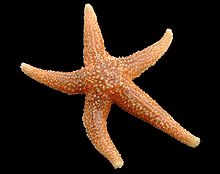
Starfish or sea stars are star-shaped echinoderms belonging to the class Asteroidea. Common usage frequently finds these names being also applied to ophiuroids, which are correctly referred to as brittle stars or basket stars. Starfish are also known as asteroids due to being in the class Asteroidea. About 1,900 species of starfish live on the seabed in all the world's oceans, from warm, tropical zones to frigid, polar regions. They are found from the intertidal zone down to abyssal depths, at 6,000 m (20,000 ft) below the surface.

Asterias is a genus of the Asteriidae family of sea stars. It includes several of the best-known species of sea stars, including the (Atlantic) common starfish, Asterias rubens, and the northern Pacific seastar, Asterias amurensis. The genus contains a total of eight species in all. All species have five arms and are native to shallow oceanic areas of cold to temperate parts of the Holarctic. These starfish have planktonic larvae. Asterias amurensis is an invasive species in Australia and can in some years become a pest in the Japanese mariculture industry.

Brittle stars, serpent stars, or ophiuroids are echinoderms in the class Ophiuroidea, closely related to starfish. They crawl across the sea floor using their flexible arms for locomotion. The ophiuroids generally have five long, slender, whip-like arms which may reach up to 60 cm (24 in) in length on the largest specimens.
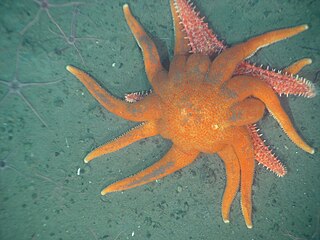
The Valvatida are an order of starfish in the class Asteroidea, which contains 695 species in 172 genera in 17 families.

The Echinasteridae are a family of starfish in the monotypic order Spinulosida. The family includes eight genera and about 133 species found on the seabed in various habitats around the world.

The Asterinidae are a large family of sea stars in the order Valvatida.
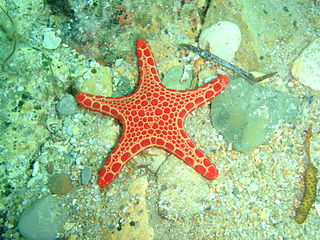
Goniasteridae constitute the largest family of sea stars, included in the order Valvatida. They are mostly deep-dwelling species, but the family also include several colorful shallow tropical species.
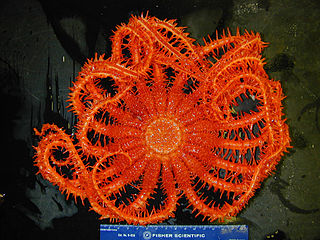
The Brisingids are deep-sea-dwelling starfish in the order Brisingida.

Henricia is a large genus of slender-armed sea stars belonging to the family Echinasteridae. It contains about fifty species.

The Brisingidae are a family of starfish found only in the deep sea. They inhabit both the Atlantic and Pacific Oceans at abyssal depths, and also occur in the Southern Ocean and around Antarctica at slightly shallower depths.

The Freyellidae are a family of deep-sea-dwelling starfish. It is one of two families in the order Brisingida. The majority of species in this family are found in Antarctic waters and near Australia. Other species have been found near New Zealand and the United States.

The Zoroasteridae are one of three families of Asteroidea in the order Forcipulatida. It contains seven living genera and one extinct genus.

Pterasteridae is a family of sea stars in the order Velatida, consisting of eight genera.
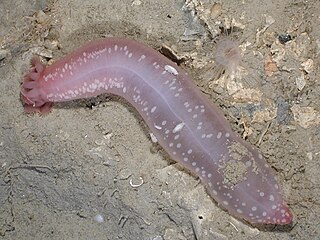
Chiridotidae is a family of sea cucumbers found in the order Apodida. Within the family, there are 16 recognized genera all with different ranges of body types and functions. Sea cucumbers play a fundamental role in many marine ecosystems.

Hippasteria muscipula is one of twelve species of deep-sea sea star in the genus Hippasteria, which is in the family Goniasteridae.
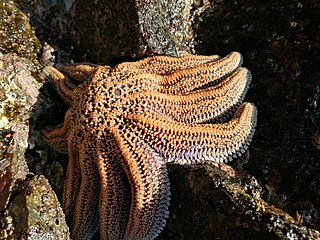
The Stichasteridae are a small family of Asteroidea in the order Forcipulatida. Genera were formerly unassigned, or in the family Asteriidae.
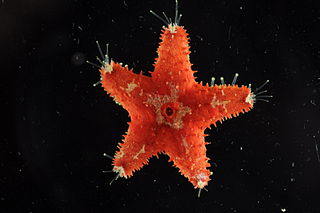
Euretaster insignis, commonly known as the striking sea star, is a species of starfish in the family Pterasteridae found in the central west Pacific Ocean. It is one of only three species in the order Velatida to be found in shallow water in the tropics. The young are brooded in a cavity underneath a "supradorsal" membrane.
Maureen Elizabeth Downey was an American zoologist who worked for three decades at the Smithsonian National Museum of Natural History. Known as "The Starfish Lady," she was an authority on sea stars and other echinoderms, co-founding the International Echinoderm Conference in 1972. Among her discoveries is Midgardia xandaros, the world's largest starfish.

The Forcipulatacea are a superorder of sea stars.

Rathbunaster is a monospecific genus of sea stars in the family Asteriidae. The genus name was given by Walter Kenrick Fisher to honor the starfish biologist Richard Rathbun of the Smithsonian Institution. He originally ranged this genus under the family Pycnopididae, synonymous with Asteriidae.
